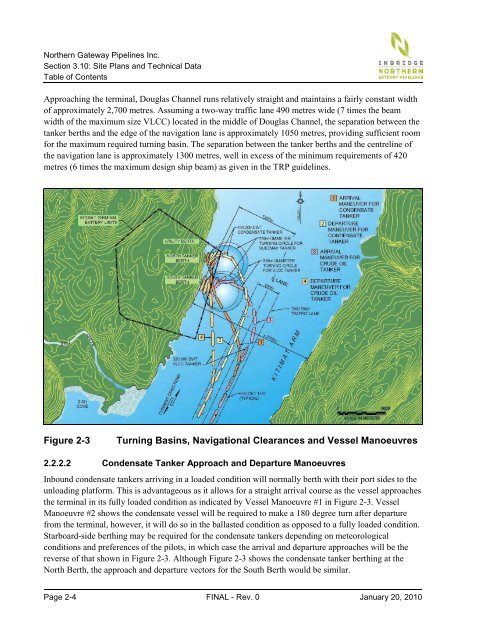Section 3.10: Site Plans and Technical Data - Rick Neufeld Comments
Section 3.10: Site Plans and Technical Data - Rick Neufeld Comments
Section 3.10: Site Plans and Technical Data - Rick Neufeld Comments
Create successful ePaper yourself
Turn your PDF publications into a flip-book with our unique Google optimized e-Paper software.
Northern Gateway Pipelines Inc.<br />
<strong>Section</strong> <strong>3.10</strong>: <strong>Site</strong> <strong>Plans</strong> <strong>and</strong> <strong>Technical</strong> <strong>Data</strong><br />
Table of Contents<br />
Approaching the terminal, Douglas Channel runs relatively straight <strong>and</strong> maintains a fairly constant width<br />
of approximately 2,700 metres. Assuming a two-way traffic lane 490 metres wide (7 times the beam<br />
width of the maximum size VLCC) located in the middle of Douglas Channel, the separation between the<br />
tanker berths <strong>and</strong> the edge of the navigation lane is approximately 1050 metres, providing sufficient room<br />
for the maximum required turning basin. The separation between the tanker berths <strong>and</strong> the centreline of<br />
the navigation lane is approximately 1300 metres, well in excess of the minimum requirements of 420<br />
metres (6 times the maximum design ship beam) as given in the TRP guidelines.<br />
Figure 2-3 Turning Basins, Navigational Clearances <strong>and</strong> Vessel Manoeuvres<br />
2.2.2.2 Condensate Tanker Approach <strong>and</strong> Departure Manoeuvres<br />
Inbound condensate tankers arriving in a loaded condition will normally berth with their port sides to the<br />
unloading platform. This is advantageous as it allows for a straight arrival course as the vessel approaches<br />
the terminal in its fully loaded condition as indicated by Vessel Manoeuvre #1 in Figure 2-3. Vessel<br />
Manoeuvre #2 shows the condensate vessel will be required to make a 180 degree turn after departure<br />
from the terminal, however, it will do so in the ballasted condition as opposed to a fully loaded condition.<br />
Starboard-side berthing may be required for the condensate tankers depending on meteorological<br />
conditions <strong>and</strong> preferences of the pilots, in which case the arrival <strong>and</strong> departure approaches will be the<br />
reverse of that shown in Figure 2-3. Although Figure 2-3 shows the condensate tanker berthing at the<br />
North Berth, the approach <strong>and</strong> departure vectors for the South Berth would be similar.<br />
Page 2-4 FINAL - Rev. 0 January 20, 2010
















